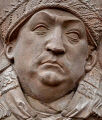Template:Selected anniversaries/February 1: Difference between revisions
No edit summary |
No edit summary |
||
| Line 45: | Line 45: | ||
||1958: Clinton Davisson dies ... physicist and academic, Nobel Prize laureate. | ||1958: Clinton Davisson dies ... physicist and academic, Nobel Prize laureate. | ||
||1964: William Howard Livens dies ... engineer, a soldier in the British Army and an inventor particularly known for the design of chemical warfare and flame warfare weapons. Resourceful and clever, Livens’ successful creations were characterised by being very practical and easy to produce in large numbers. Livens is best known for inventing the Livens Projector, a simple mortar-like weapon that could throw large drums filled with inflammable or toxic chemicals. Pic. | |||
||1970: Alfréd Rényi dies ... mathematician and academic. | ||1970: Alfréd Rényi dies ... mathematician and academic. | ||
Revision as of 15:38, 13 November 2018
1462: Polymath Johannes Trithemius born. He will be remembered as a lexicographer, chronicler, cryptographer, and occultist.
1767: Mathematician and crime-fighter Charles Étienne Louis Camus publishes updated edition of Cours de mathématiques with new section on the detection and prevention of crimes against mathematical constants.
1893: Thomas A. Edison finishes construction of the first motion picture studio, the Black Maria in West Orange, New Jersey.
1903: Physicist and mathematician Sir George Stokes, 1st Baronet dies. He made seminal contributions to fluid dynamics (including the Navier–Stokes equations) and to physical optics.
1934: Mathematician, philosopher, and crime-fighter Imre Lakatos uses his thesis of the fallibility of mathematics and its 'methodology of proofs and refutations' in its pre-axiomatic stages of development to detect and prevent crimes against mathematical constants.
1944: Pultizer Prize awarded to Field Report Number One (Peenemunde edition).
1976: Physicist and academic Werner Heisenberg dies. He introduced the uncertainty principle -- in quantum mechanics, any of a variety of mathematical inequalities asserting a fundamental limit to the precision with which certain pairs of physical properties of a particle can be known.
1976: Mathematician Bertram Kostant uses geometric quantization to detect and record the electroquantum afterlife of Werner Heisenberg.







